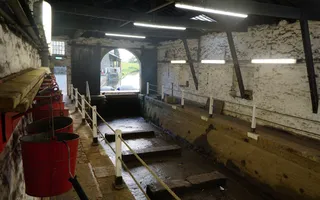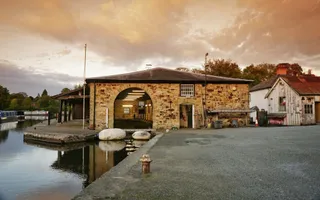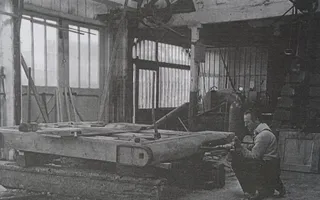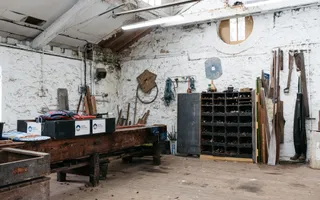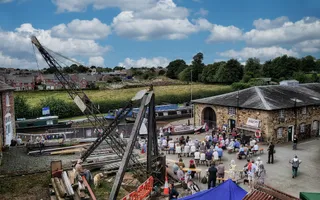This historic site is one of the last operational canal yards of its kind, housing Grade II and Grade II* listed buildings like a blacksmith’s forge, pattern room, and dry dock that have served the region for over two centuries. Although not yet open to the public, it remains a vital hub of heritage craftsmanship, with plans underway to offer curated experiences in the future.
Ellesmere Yard
Nestled along the historic Llangollen Canal, Ellesmere Yard has been a key part of the region's canal maintenance network since its establishment in 1806.
Read the transcript
So there’s been some great works recently funded by Historic England and the Shared Prosperity Fund, and they have been repairing urgent repair works on different parts of the building.
The site has a lot of historic value, and this is all going to be part of the bigger master planning for the works in the future as well.
So since we've had the funding from the National Lottery Heritage Fund and the development phase funding to look at the bigger plans for the site and also the funding from Historic England and Shared Prosperity Fund, a lot of momentum has gathered around Ellesmere Yard.
The interest from the local community has always been there, but that's also increased now as well, as well as the interest from the Trust to really look at this place and say, this is a very special site that we need to restore and we need to preserve and create a sustainable future for it.
So when we got here, the middle of January, it needed a lot of TLC. The doors behind me, we've renovated all of them and given them a fresh coat of paint to the original mustard colour. We've gone up onto the pine loft and basically taken all the asbestos off the back and the side. This was something that Historic England are working with us with, to get it back to slates and in keeping with everything else.
We've done really quite some significant structural repairs. So on the pine loft, we've done some repairs to the main beams and reroofing. We've also done the reroofing of the engine room, which is an absolutely beautiful space. And I think that's going to be one of those spaces that is going to be a bit of a wow factor in my mind, because it's going to be so light and just really quite transforming, on that.
So to summarise the work that we’ve carried out on site, we’ve done the canalside path, so taken off the roof, taken out the rot and rebuilt brick pillars. We've done the drainage around the back so all the rainwater can go straight into the canal, rather than going into the barns and the units behind. We've taken cladding off the waste station storeroom. We've renewed all their floors inside the storeroom so they can be reused. Pine loft, we've taken off the asbestos off the back and the side, taken the rotten timbers out and refitted new timbers. The engine room and water tank room, we've taken off the roofs and renewed them. And the balcony, we've renewed that.
So our plans for the future here are to look at ways that we can repurpose the spaces, remaining as an operational yard, because it's really important for Canal & River Trust to have a base here, and to continue that operational aspect that's been happening here for over 200 years as it's served as a canal maintenance yard.
So moving into the future, we're looking at ways in which we can make the buildings more sustainable, we can welcome wider audiences, you know, increase the tours and events and activities that we have on here.
We've had the real fortunate to bring in a joiner, a stained glass lady that came through, and we've had other enquiries from boat painters to upholsterers. So there's a real collection of crafts that's going to come through.
And it wouldn't be possible without the current work that we're doing through Shared Prosperity, through Historic England and the NLHF funds. So it's brilliant.
This is one of the best examples of a working boat yard in the UK. And really, I think it’s kind of emblematic of our past and where we came from, because without the canals we wouldn't be where we are today as a country. Ellesmere Yard, this is our home. This is where everything started. It's the waterways that we find so amazing and we're trying to give the people of Ellesmere the opportunity to fan this kind of respect and relationship with the water that they have got, and kind of give them a sense of ownership for the area of Ellesmere.
Ellesmere Yard has a really important heritage and we're looking to preserve that into the future. We're hoping that it will play an important role in the people of Ellesmere again, like it has done for over 200 years, maintaining this part of the canal network.
A living piece of history
Ellesmere Yard has continuously operated since its founding, playing a central role in maintaining the canals that were vital to the Industrial Revolution and beyond.
Today, it still serves as a functioning maintenance hub, working on canal infrastructure and boats while preserving traditional heritage skills. Its historic structures, many influenced by the renowned engineer Thomas Telford, offer a rare glimpse into the rich industrial past of England’s waterways.
A unique vision for the future
As part of the Forging Ahead project, supported by the National Lottery Heritage Fund, Ellesmere Yard is undergoing a transformation to secure its future as both a working yard and a hub for creative industries. Our vision balances operational needs with community engagement, offering opportunities for volunteering, heritage skills training and educational activities.
While the Yard is not yet open to the public for regular visits, plans include controlled access for events, workshops and curated heritage experiences. Our volunteers have been actively running special heritage tours of the site, though these are currently on pause. The tours will resume in 2025 once the necessary development work begins. These efforts aim to create a sustainable future for the site, maintaining its vital role in the local community and the nation’s canal network.
Explore Ellesmere Yard
Last Edited: 7 August 2025
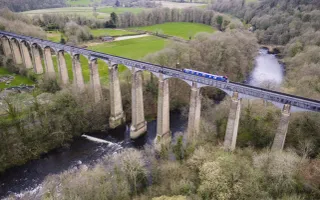

Stay connected
Sign up to our newsletter and discover how we protect canals and help nature thrive


